Generate Invoices

Hank the Tank now indicates that we are at the Generate Invoices step of the invoice run. This step is predominantly for the generation of invoices, as the name suggests, but it is also the step at which invoice adjustments may be applied and invoice-specific notes added.

If more shifts have been subsequently confirmed, the user may click the ‘Back’ button, as shown above, to return to the Submit Dockets step and submit the dockets for the newly confirmed shifts.
If no further shifts have been confirmed, the user will still be able to click ‘Back’, but they will be prevented from opening the Submit Dockets screen.
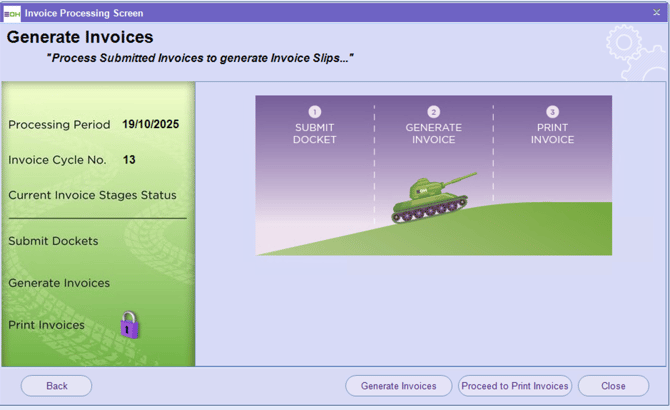
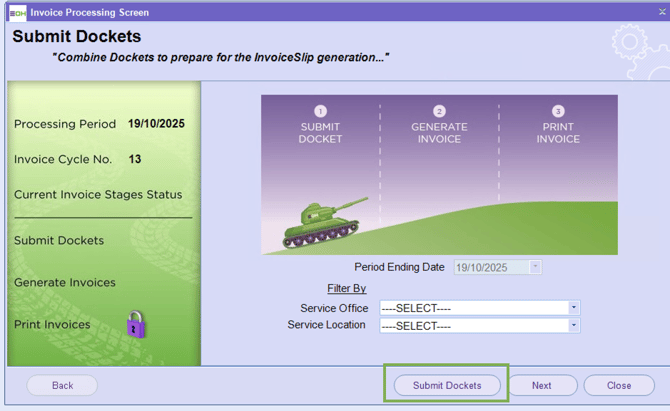

The clients that were selected to proceed from the Submit Dockets stage can be seen listed on the screen. There are several points to note on this screen:
-
Filter functionality at the top of each column allows the user to filter for certain clients.

-
The column order may be changed to suit user preferences by dragging and dropping the column name to another position.

-
The sort order of each column may be changed by clicking on the column name.

-
-
An Invoice Number is generated for each client’s invoice.
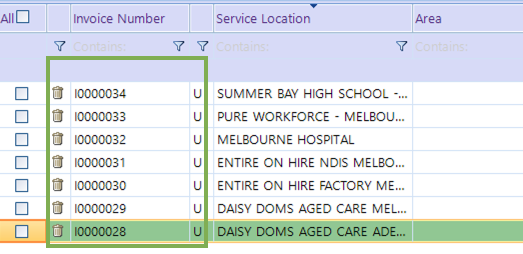
-
The trash bin symbol at the start of each row allows clients to be deleted from this stage of the invoice run. This is used if an error is detected in the row details. Deleting the client sends all the client’s shifts back to the Submit Dockets stage. It may also be necessary to further delete the shifts from the Submit Dockets stage, so that they can be updated and confirmed again in the earlier Confirm Shifts stage.

-
The company’s banking details (for invoice receivables) can be seen in the header of the screen, circled in red below.

-
A one-time message can be specified in the Invoice Announcement field, circled in red below. This message will be displayed on all invoices for the current invoice run only.
-
A continuous message can be specified in the Invoice Instructions field, also circled in red below. This message will be displayed continuously on all invoices, for all invoice runs, unless removed or updated. Note that this message may also be specified in the Finance Portal at / Tools / Application Options / Payroll.

To process this stage of the invoice run, follow these steps:
(a)Review client invoice details displayed on each row.

(b) If any errors are detected, delete the client so that the client’s shifts return to the Submit Dockets stage.

(c)Update the Invoice Announcement and Invoice Instructions fields as required.

(d) Select the clients that are to proceed into the next stage of the invoice run by checking the checkbox next to each client’s name. If all clients are to be selected, then the checkbox in the header may be selected which automatically checks all client checkboxes.
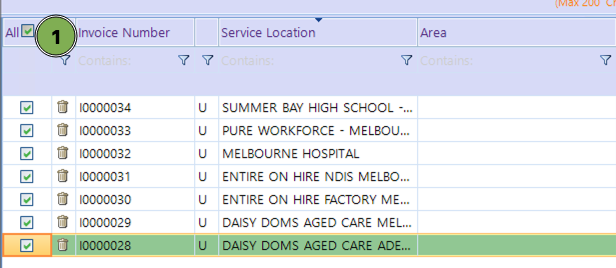
(e)Click on the ‘Generate Invoices’ button. If there are issues with the generation, an alert message will be displayed as in the example below.
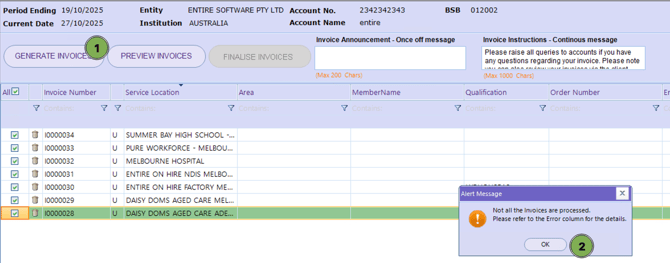
(f) Click on the OK button of the alert message and refer to the Error column to view the details, as shown below.

(g) In this example, client invoice delivery type information is missing, and so the invoice run cannot continue until the issues are rectified. In this case, the client records may be updated with the missing details and then the invoices generated again, or the affected clients may be simply deleted from this invoice run by using the trash bin icon.
Example you can see this data is missing - 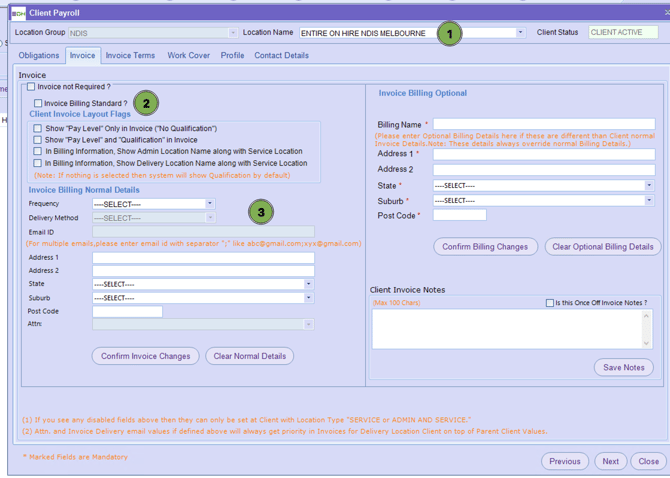
Once updated, this will correct the error
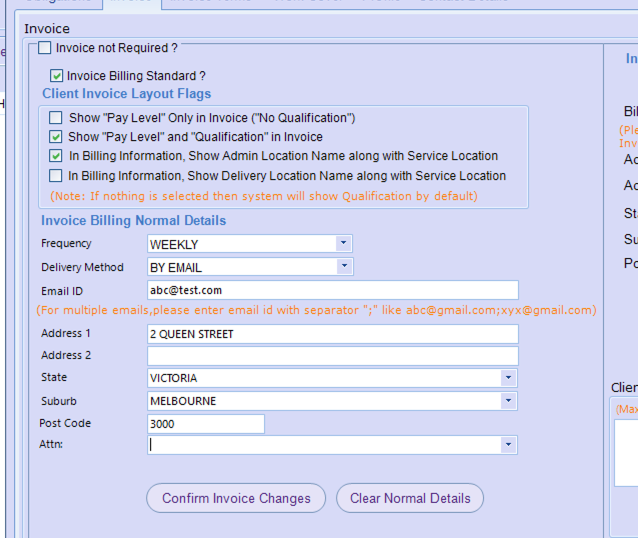
Then you can regenerate the invoices and will not receive an error and you can go on to the next step.
(h)If there are no issues with the invoice generation, or the issues have been resolved, a confirmation message will be displayed, as shown below, and the user is advised to preview and then finalize the invoices.

(i)Click on OK of the confirmation message and then click on the ’Preview Invoices’ button. A preview screen is then displayed, showing all sample invoices, as can be seen below.

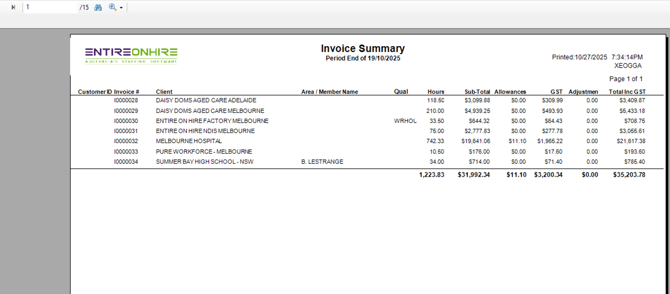

(j)Close the invoice preview screen and the Generate Invoices Screen is displayed once again. Note that each of the invoice numbers now has a hyperlink, as circled below.
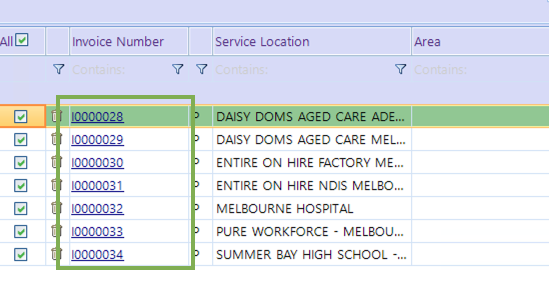
(k)If there are no further updates to be made to the invoices, then the invoices may be finalised by clicking the ‘Finalise Invoices’ button.

If further updates are required, each individual invoice may be updated by clicking on the Invoice Number hyperlink. This opens the Invoice Manager Screen. From this screen, the user may change the display of shifts on the screen, delete specific shifts from the invoice, add invoice-specific invoice notes, and add invoice adjustments and descriptions. These are explained below:
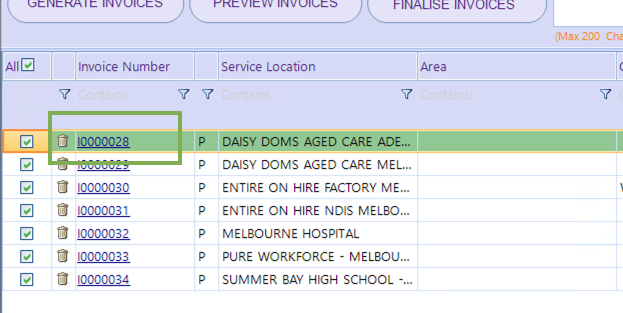
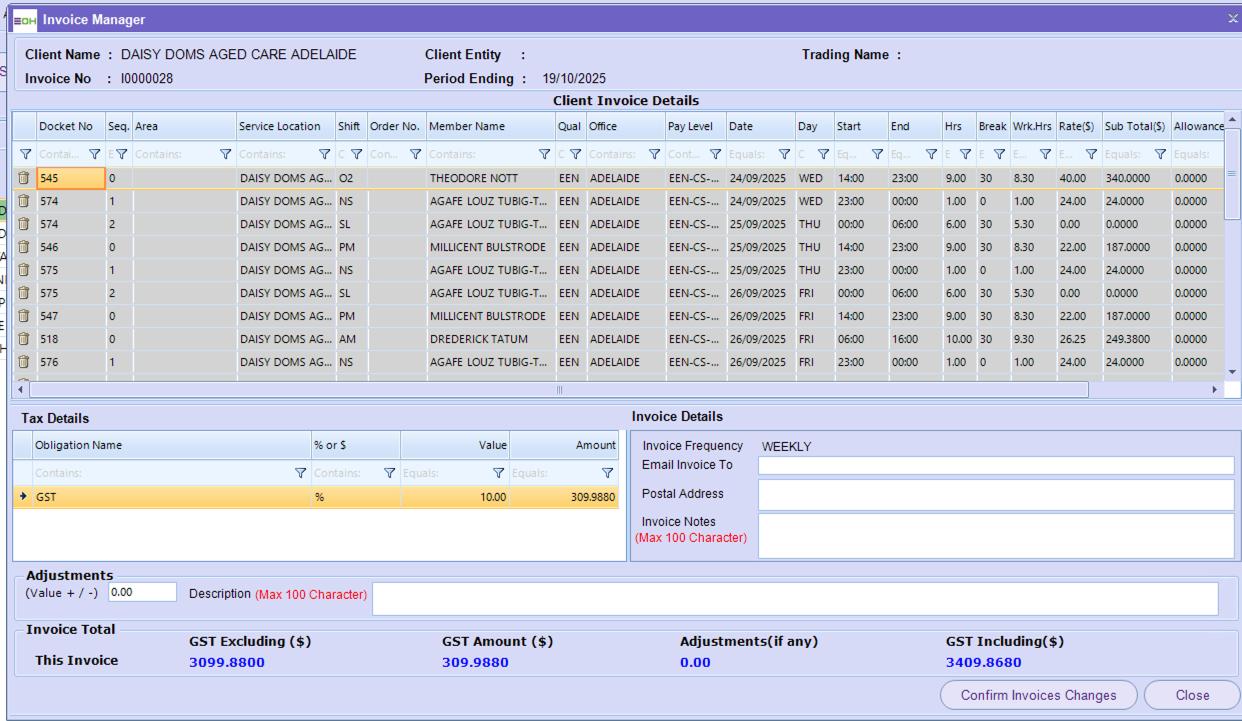
Invoice Manager – Changing On-Screen Shift Display
As with other screens, the user may change the way shifts are displayed on the screen. Filter functionality at the top of each column allows the user to filter for certain shifts.
The column order may be changed to suit user preferences by dragging and dropping the column name to another position, and the sort order of each column may be changed by clicking on the column name.

Invoice Manager – Deleting Specific Shifts from the Invoice
The trash bin symbol at the start of each row allows specific shifts to be deleted from the invoice. This is used if an error is detected in the row details or if the shift is not to be included in the current invoice run.
Using this feature will send the shift back to the Submit Dockets stage. From there the shift may be processed again in the Submit Dockets stage, deleted again so it is sent further back to the Confirm Shifts stage for updating, or may be left to sit in the Submit Dockets stage to be processed in a subsequent invoice run.

Note that if the trash bin symbol is used from the previous Generate Invoice Screen, all of the client’s shifts are deleted, but if it is used from the Invoice Manager Screen, then specific shifts may be deleted one at a time.
Note also that the user will not be permitted to delete specific shifts in the Invoice Manager Screen if the corresponding payslips have already been generated.
Invoice Manager – Adding an Invoice-Specific Message
In addition to the Invoice Announcement and the Invoice Instructions messages (which apply to all invoices), it is sometimes necessary to add a message to a single invoice. Such messages may be added to the Invoice Notes field, circled in red below. If there are multiple shifts listed in the invoice, and the message relates to specific shifts, then the docket number of the shifts may be referred to, to identify the shift, as in the example below. Click the ‘Confirm Invoice Changes’ button to save the invoice notes.
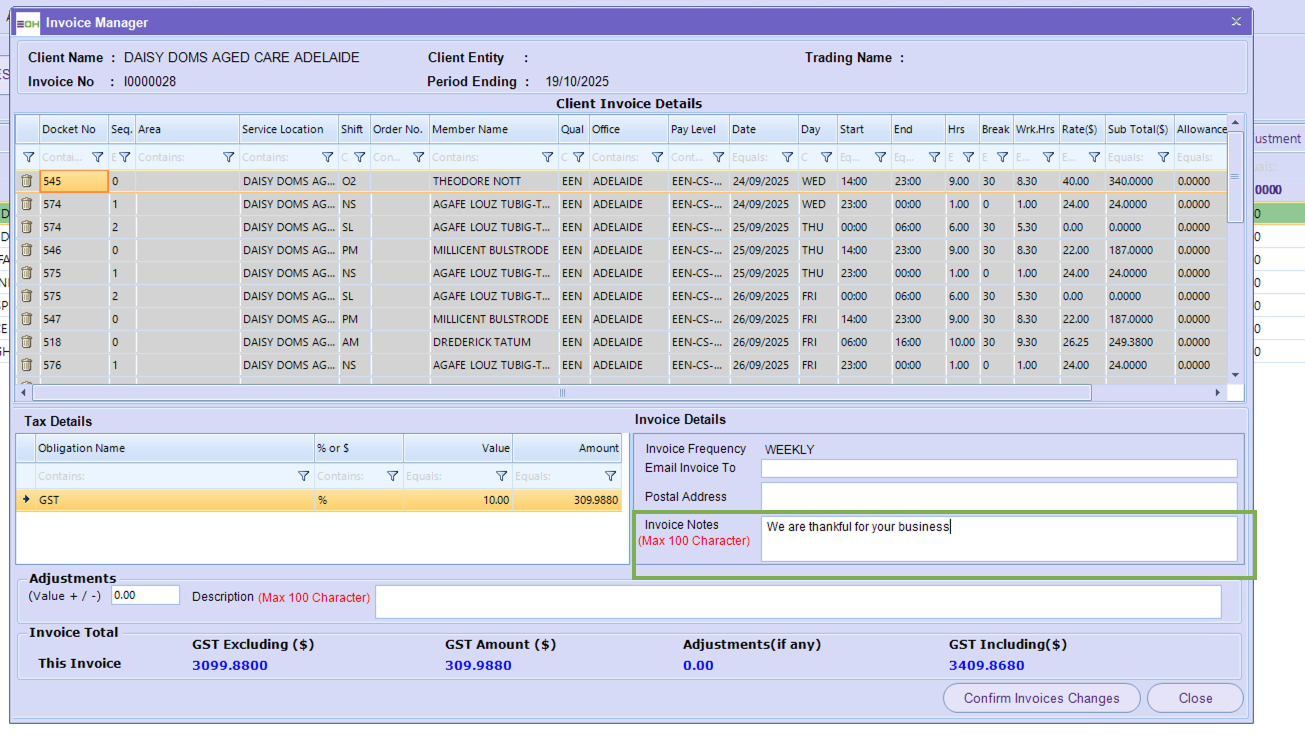
Handy Hint
Invoice Notes may be added to the invoice using the Invoice Manager Screen, as described above, but they may also be added to the client’s Client Record. When added to the Client Record, the notes are specified as being a one-time occurrence or for multiple occurrences.
If it is a one-time occurrence, it will be added to the invoice in the next applicable invoice run. If it is for multiple occurrences, it will be added to multiple invoices for the client over multiple invoice runs.
The Invoice tab of the Client Record is shown below, displaying the Client Invoice Notes field circled in green.

Invoice Manager – Adding an Adjustment
It is possible to add and subtract amounts from the overall invoice total using the Adjustments section of the Invoice Manager Screen. This functionality may be useful for many reasons. For example, companies may wish to reward their clients with a loyalty bonus by applying a percentage discount to the overall invoice value, as can be seen in the screenshot below. The amount is entered into the ‘Value’ field and an explanation is provided in the ‘Description’ field. Clicking on the ‘Confirm Invoice Changes’ button will save the adjustment and description.
Note that, as can be seen in the example below, any negative adjustments should be preceded by a minus sign. Also note that only absolute values may be entered, so if a percentage increase or decrease is to be applied, the amount needs to be calculated outside of the system.
Click on the Close button to close the Invoice Manager Screen.
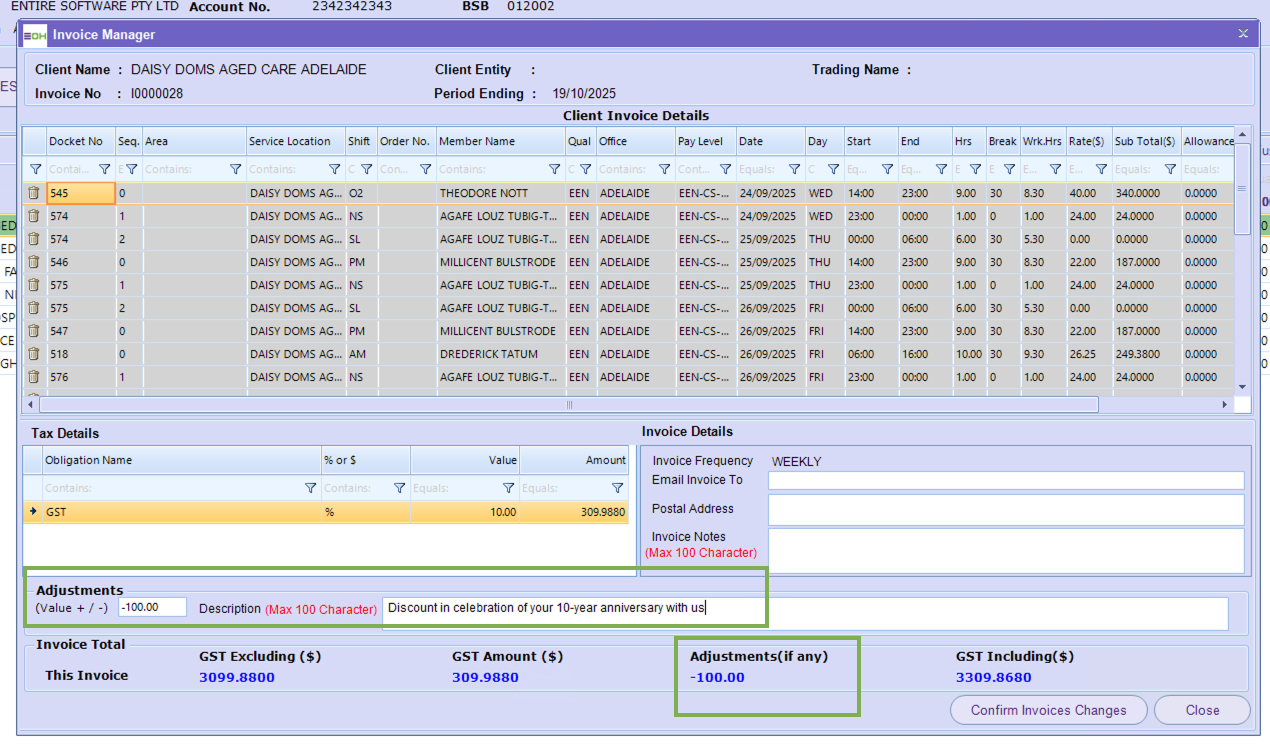
(l) Once all updates have been made in the Invoice Manager Screen, click on the ‘Preview Invoices’ button once again to preview the updated invoices. This is important because shifts may have been deleted and adjustments may have been applied, both of which will mean that the invoices previewed earlier will now be different.


Important Note
If updates are made in the Invoice Manager Screen, these updates will be automatically reflected in the invoices (and this can be seen by previewing the invoices as suggested above).
However, if any updates are made to the Client Record during invoice run processing (such as adding a client invoice note), then the updates are not automatically reflected in the invoice, and the invoice must be generated again for the update to take effect.
To generate the invoice again, check the checkbox at the start of the client row and click on the ‘Generate Invoices’ button.
(m) Once all updates have been made, and invoices have been previewed, click on the ‘Finalize Invoices’ button.

(n) The user is then notified that the invoices have been successfully finalized and instructed to close the screen and create an email batch to send invoices to clients, as can be seen below.
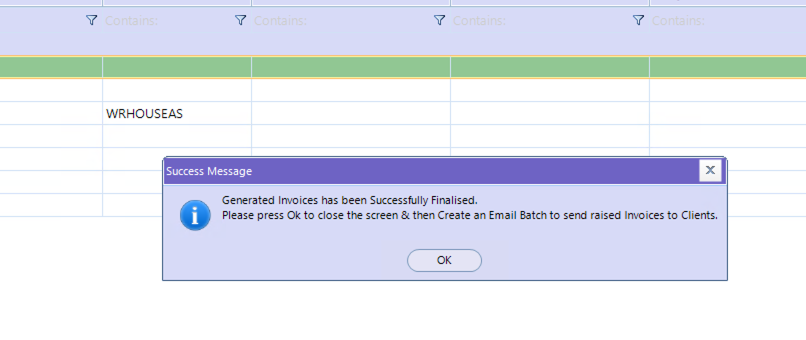
(p) Click on OK of the confirmation message. The Invoice Processing Summary Screen is displayed once again. Click on the ‘Proceed to Print Invoices’ button to move to the next stage of the invoice run, Print Invoice, as shown below.
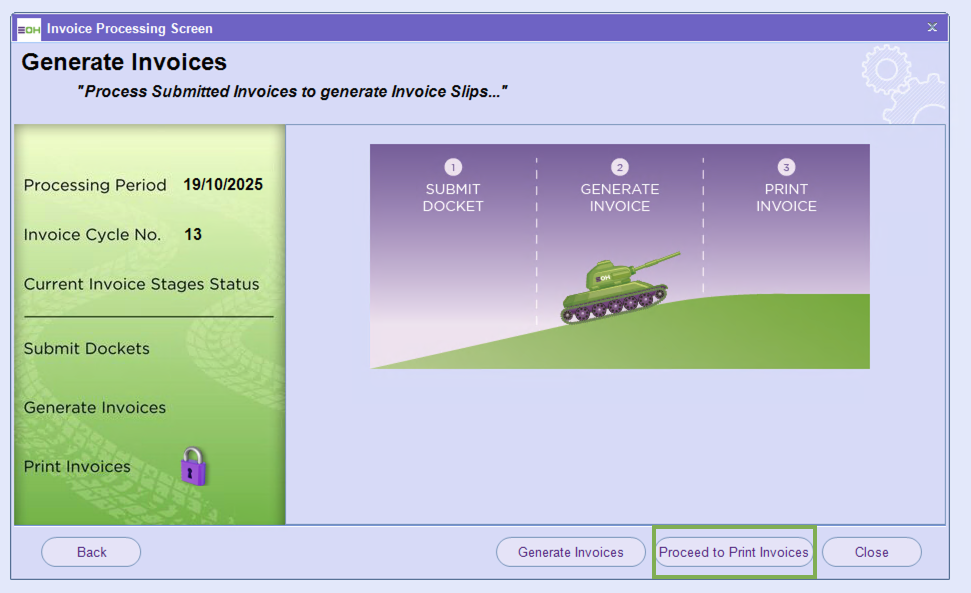
Next Step - Print Invoices

